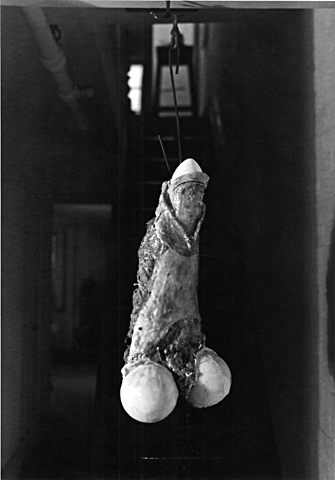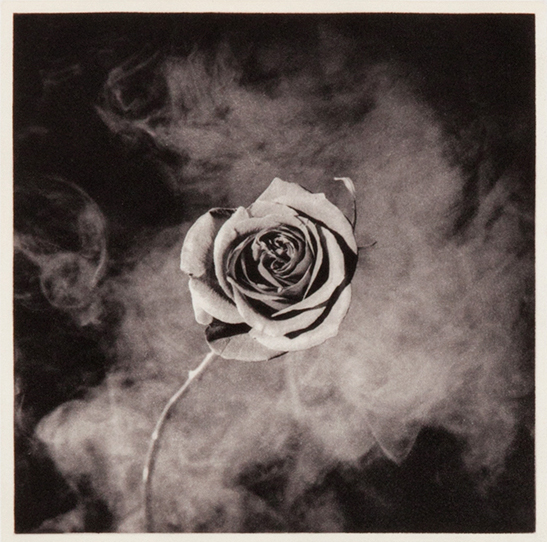 Patti Smith (Boat to Fire Island), Robert Mapplethorpe, circa 1971-74
Patti Smith (Boat to Fire Island), Robert Mapplethorpe, circa 1971-74
LE BATEAU IVRE
Comme je descendais des Fleuves impassibles,
Je ne me sentis plus guidé par les haleurs :
Des Peaux-Rouges criards les avaient pris pour cibles,
Les ayant cloués nus aux poteaux de couleurs.
J’étais insoucieux de tous les équipages,
Porteur de blés flamands ou de cotons anglais.
Quand avec mes haleurs ont fini ces tapages,
Les Fleuves m’ont laissé descendre où je voulais.
Dans les clapotements furieux des marées,
Moi, l’autre hiver, plus sourd que les cerveaux d’enfants,
Je courus ! Et les Péninsules démarrées
N’ont pas subi tohu-bohus plus triomphants.
La tempête a béni mes éveils maritimes.
Plus léger qu’un bouchon j’ai dansé sur les flots
Qu’on appelle rouleurs éternels de victimes,
Dix nuits, sans regretter l’oeil niais des falots!
Plus douce qu’aux enfants la chair des pommes sûres,
L’eau verte pénétra ma coque de sapin
Et des taches de vins bleus et des vomissures
Me lava, dispersant gouvernail et grappin.
Et dès lors, je me suis baigné dans le Poème
De la Mer, infusé d’astres, et lactescent,
Dévorant les azurs verts ; où, flottaison blême
Et ravie, un noyé pensif parfois descend;
Où, teignant tout à coup les bleuités, délires
Et rhythmes lents sous les rutilements du jour,
Plus fortes que l’alcool, plus vastes que nos lyres,
Fermentent les rousseurs amères de l’amour!
Je sais les cieux crevant en éclairs, et les trombes
Et les ressacs et les courants : je sais le soir,
L’Aube exaltée ainsi qu’un peuple de colombes,
Et j’ai vu quelquefois ce que l’homme a cru voir!
J’ai vu le soleil bas, taché d’horreurs mystiques,
Illuminant de longs figements violets,
Pareils à des acteurs de drames très antiques
Les flots roulant au loin leurs frissons de volets!
J’ai rêvé la nuit verte aux neiges éblouies,
Baiser montant aux yeux des mers avec lenteurs,
La circulation des sèves inouïes,
Et l’éveil jaune et bleu des phosphores chanteurs!
J’ai suivi, des mois pleins, pareille aux vacheries
Hystériques, la houle à l’assaut des récifs,
Sans songer que les pieds lumineux des Maries
Pussent forcer le mufle aux Océans poussifs!
J’ai heurté, savez-vous, d’incroyables Florides
Mêlant aux fleurs des yeux de panthères à peaux
D’hommes ! Des arcs-en-ciel tendus comme des brides
Sous l’horizon des mers, à de glauques troupeaux!
J’ai vu fermenter les marais énormes, nasses
Où pourrit dans les joncs tout un Léviathan!
Des écroulements d’eaux au milieu des bonaces,
Et les lointains vers les gouffres cataractant!
Glaciers, soleils d’argent, flots nacreux, cieux de braises!
Échouages hideux au fond des golfes bruns
Où les serpents géants dévorés des punaises
Choient, des arbres tordus, avec de noirs parfums!
J’aurais voulu montrer aux enfants ces dorades
Du flot bleu, ces poissons d’or, ces poissons chantants.
– Des écumes de fleurs ont bercé mes dérades
Et d’ineffables vents m’ont ailé par instants.
Parfois, martyr lassé des pôles et des zones,
La mer dont le sanglot faisait mon roulis doux
Montait vers moi ses fleurs d’ombre aux ventouses jaunes
Et je restais, ainsi qu’une femme à genoux…
Presque île, ballottant sur mes bords les querelles
Et les fientes d’oiseaux clabaudeurs aux yeux blonds.
Et je voguais, lorsqu’à travers mes liens frêles
Des noyés descendaient dormir, à reculons!
Or moi, bateau perdu sous les cheveux des anses,
Jeté par l’ouragan dans l’éther sans oiseau,
Moi dont les Monitors et les voiliers des Hanses
N’auraient pas repêché la carcasse ivre d’eau;
Libre, fumant, monté de brumes violettes,
Moi qui trouais le ciel rougeoyant comme un mur
Qui porte, confiture exquise aux bons poètes,
Des lichens de soleil et des morves d’azur;
Qui courais, taché de lunules électriques,
Planche folle, escorté des hippocampes noirs,
Quand les juillets faisaient crouler à coups de triques
Les cieux ultramarins aux ardents entonnoirs;
Moi qui tremblais, sentant geindre à cinquante lieues
Le rut des Béhémots et les Maelstroms épais,
Fileur éternel des immobilités bleues,
Je regrette l’Europe aux anciens parapets!
J’ai vu des archipels sidéraux ! et des îles
Dont les cieux délirants sont ouverts au vogueur :
– Est-ce en ces nuits sans fonds que tu dors et t’exiles,
Million d’oiseaux d’or, ô future Vigueur?
Mais, vrai, j’ai trop pleuré ! Les Aubes sont navrantes.
Toute lune est atroce et tout soleil amer :
L’âcre amour m’a gonflé de torpeurs enivrantes.
Ô que ma quille éclate ! Ô que j’aille à la mer!
Si je désire une eau d’Europe, c’est la flache
Noire et froide où vers le crépuscule embaumé
Un enfant accroupi plein de tristesse, lâche
Un bateau frêle comme un papillon de mai.
Je ne puis plus, baigné de vos langueurs, ô lames,
Enlever leur sillage aux porteurs de cotons,
Ni traverser l’orgueil des drapeaux et des flammes,
Ni nager sous les yeux horribles des pontons.
Arthur Rimbaud
1871
__________________________________
“As I was going down impassive Rivers,
I no longer felt myself guided by haulers:
Yelping redskins had taken them as targets
And had nailed them naked to colored stakes.
I was indifferent to all crews,
The bearer of Flemish wheat or English cottons
When with my haulers this uproar stopped
The Rivers let me go where I wanted.
Into the furious lashing of the tides
More heedless than children’s brains the other winter
I ran! And loosened Peninsulas
Have not undergone a more triumphant hubbub
The storm blessed my sea vigils
Lighter than a cork I danced on the waves
That are called eternal rollers of victims,
Ten nights, without missing the stupid eye of the lighthouses!
Sweeter than the flesh of hard apples is to children
The green water penetrated my hull of fir
And washed me of spots of blue wine
And vomit, scattering rudder and grappling-hook
And from then on I bathed in the Poem
Of the Sea, infused with stars and lactescent,
Devouring the azure verses; where, like a pale elated
Piece of flotsam, a pensive drowned figure sometimes sinks;
Where, suddenly dyeing the blueness, delirium
And slow rhythms under the streaking of daylight,
Stronger than alcohol, vaster than our lyres,
The bitter redness of love ferments!
I know the skies bursting with lightning, and the waterspouts
And the surf and the currents; I know the evening,
And dawn as exalted as a flock of doves
And at times I have seen what man thought he saw!
I have seen the low sun spotted with mystic horrors,
Lighting up, with long violet clots,
Resembling actors of very ancient dramas,
The waves rolling far off their quivering of shutters!
I have dreamed of the green night with dazzled snows
A kiss slowly rising to the eyes of the sea,
The circulation of unknown saps,
And the yellow and blue awakening of singing phosphorous!
I followed during pregnant months the swell,
Like hysterical cows, in its assault on the reefs,
Without dreaming that the luminous feet of the Marys
Could constrain the snout of the wheezing Oceans!
I struck against, you know, unbelievable Floridas
Mingling with flowers panthers’ eyes and human
Skin! Rainbows stretched like bridal reins
Under the horizon of the seas to greenish herds!
I have seen enormous swamps ferment, fish-traps
Where a whole Leviathan rots in the rushes!
Avalanches of water in the midst of a calm,
And the distances cataracting toward the abyss!
Glaciers, suns of silver, nacreous waves, skies of embers!
Hideous strands at the end of brown gulfs
Where giant serpents devoured by bedbugs
Fall down from gnarled trees with black scent!
I should have liked to show children those sunfish
Of the blue wave, the fish of gold, the singing fish.
—Foam of flowers rocked my drifting
And ineffable winds winged me at times.
At times a martyr weary of poles and zones,
The sea, whose sob created my gentle roll,
Brought up to me her dark flowers with yellow suckers
And I remained, like a woman on her knees…
Resembling an island tossing on my sides the quarrels
And droppings of noisy birds with yellow eyes
And I sailed on, when through my fragile ropes
Drowned men sank backward to sleep!
Now I, a boat lost in the foliage of caves,
Thrown by the storm into the birdless air
I whose water-drunk carcass would not have been rescued
By the Monitors and the Hanseatic sailboats;
Free, smoking, topped with violet fog,
I who pierced the reddening sky like a wall,
Bearing, delicious jam for good poets
Lichens of sunlight and mucus of azure,
Who ran, spotted with small electric moons,
A wild plank, escorted by black seahorses,
When Julys beat down with blows of cudgels
The ultramarine skies with burning funnels;
I, who trembled, hearing at fifty leagues off
The moaning of the Behemoths in heat and the thick Maelstroms,
Eternal spinner of the blue immobility
I miss Europe with its ancient parapets!
I have seen sidereal archipelagos! and islands
Whose delirious skies are open to the sea-wanderer:
—Is it in these bottomless nights that you sleep and exile yourself,
Million golden birds, o future Vigor? –
But, in truth, I have wept too much! Dawns are heartbreaking.
Every moon is atrocious and every sun bitter.
Acrid love has swollen me with intoxicating torpor
O let my keel burst! O let me go into the sea!
If I want a water of Europe, it is the black
Cold puddle where in the sweet-smelling twilight
A squatting child full of sadness releases
A boat as fragile as a May butterfly.
No longer can I, bathed in your languor, o waves,
Follow in the wake of the cotton boats,
Nor cross through the pride of flags and flames,
Nor swim under the terrible eyes of prison ships.”

A reissue of Rimbaud’s highly influential work, with a new preface by Patti Smith and the original 1945 New Directions cover design by Alvin Lustig
In 2011 New Directions relaunched the long-celebrated bi-lingual edition of Rimbaud’s A Season In Hell and The Drunken Boat — a personal poem of damnation as well as a plea to be released from “the examination of his own depths.”
Rimbaud originally distributed A Season In Hell to friends as a self-published booklet, and soon afterward, at the age of nineteen, quit poetry altogether. New Directions’s edition was among the first to be published in the U.S., and it quickly became a classic. Rimbaud’s famous poem The Drunken Boat was subsequently added to the first paperbook printing. Allen Ginsberg proclaimed Arthur Rimbaud as “the first punk” — a visionary mentor to the Beats for both his recklessness and his fiery poetry.




















































